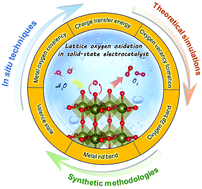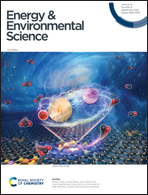Lattice oxygen redox chemistry in solid-state electrocatalysts for water oxidation
Abstract
Fundamental understanding of oxygen evolution reaction (OER) is of vital importance as it dominates the overall efficiency of water electrolysis – a compelling technique for sustainable production of hydrogen feedstock. Recently, a lattice oxygen-mediated mechanism (LOM) derived from lattice oxygen redox chemistry has received a lot of attention as it can rationalize the highly intrinsic activity and surface reconstruction issue in solid-state electrocatalyst alternatives with high metal–oxygen covalency. The physicochemical fundamentals of LOM further guide the exploration of efficient OER electrocatalysts. In this review, we comprehensively summarize the recent progress in lattice oxygen redox chemistry in solid-state OER electrocatalysts and its induced LOM. We begin with a brief introduction of LOM together with proposed pathways, and discuss the fundamental correlations between electronic structure of catalysts and OER mechanism to provide several electronic descriptors. Subsequently, we summarize the strategies for triggering lattice oxygen redox chemistry to promote the intrinsic OER activity, together with the theoretical calculations and experimental measurements for corroboration of lattice oxygen oxidation. Finally, we offer an outlook of the remaining challenges and future perspectives towards lattice oxygen redox chemistry in OER electrocatalysts. We anticipate that this review can inspire researchers to develop this attractive research area together.

- This article is part of the themed collection: SDG12: Sustainable production of energy materials


 Please wait while we load your content...
Please wait while we load your content...